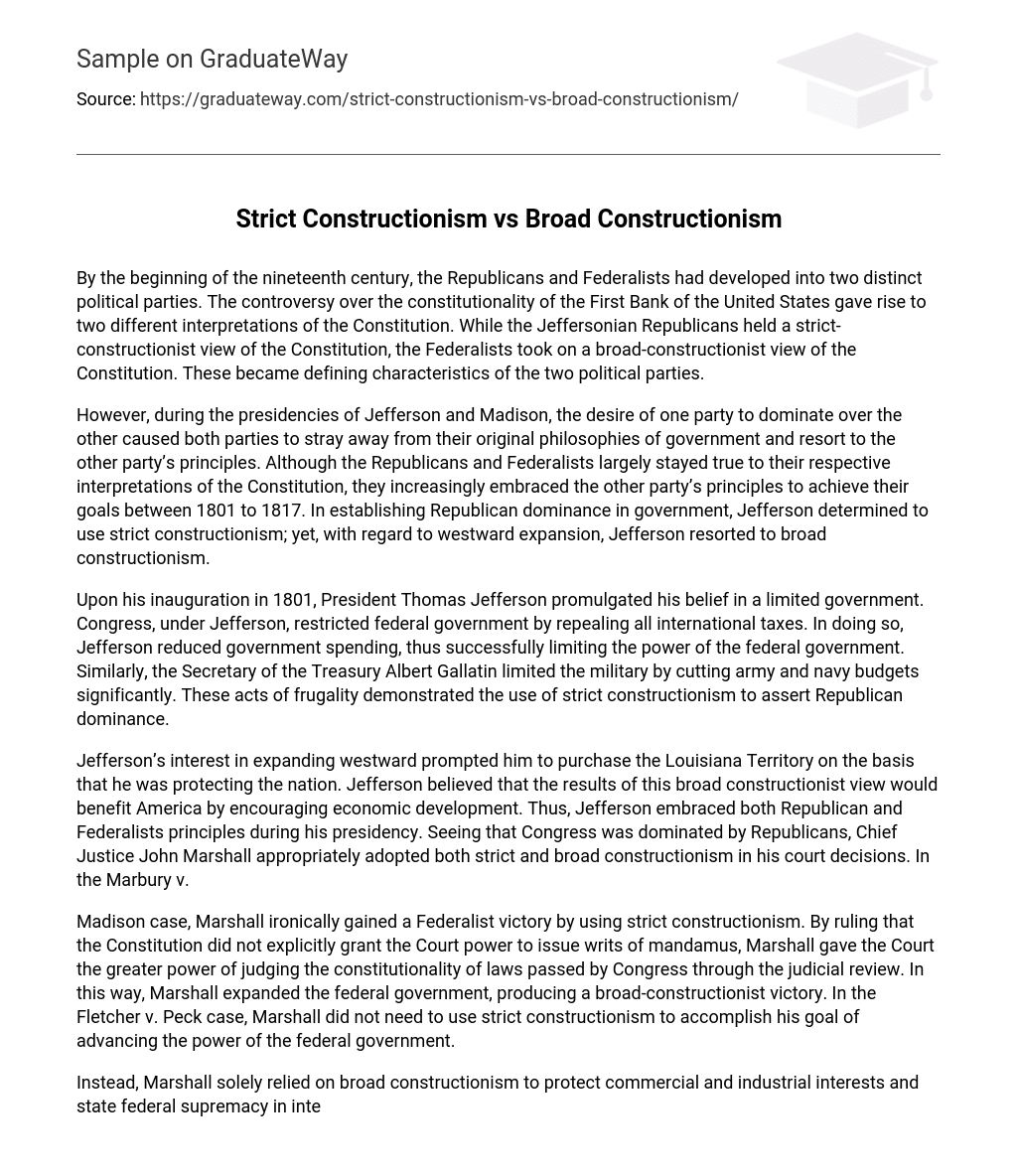During the early 1800s, the emergence of two political parties, the Republicans and Federalists, was a result of their divergent interpretations of the Constitution. The debate over whether the First Bank of the United States was constitutional led to differing views on how to interpret this important document. Led by Thomas Jefferson, the Republican Party advocated for a strict interpretation of the Constitution, while the Federalist Party embraced a more expansive understanding. These contrasting perspectives became defining characteristics of these political groups.
Both the Republicans and Federalists during the presidencies of Jefferson and Madison strayed from their initial government philosophies in pursuit of dominance over each other. While they generally stuck to their own understandings of the Constitution, from 1801 to 1817, they progressively embraced the principles of the opposing party to accomplish their goals. For instance, Jefferson utilized strict constructionism to assert Republican authority in government, but when it came to expanding westward, he adopted broad constructionism.
President Thomas Jefferson, upon assuming office in 1801, conveyed his support for a limited government. Throughout his presidency, Congress, under Jefferson’s guidance, endeavored to curtail the authority of the federal government by eliminating all international taxes. This choice resulted in reduced governmental expenditures and effectively restricted the power of the federal government. Moreover, Secretary of the Treasury Albert Gallatin implemented budget reductions for both the army and navy, further exemplifying a dedication to thriftiness. These actions demonstrated strict constructionism as a strategy for asserting Republican control.
Jefferson’s desire to expand westward led him to buy the Louisiana Territory in order to protect the nation. He believed that taking this expansive view would benefit America by promoting economic growth. As a result, Jefferson embraced both Republican and Federalist principles during his time as president. Chief Justice John Marshall, observing that Congress was dominated by Republicans, made decisions in his court that were a blend of strict and broad constructionism. This was evident in the Marbury v. Madison case.
In the case of Madison, Marshall ironically achieved a Federalist victory by employing strict constructionism. By declaring that the Constitution did not explicitly empower the Court to issue writs of mandamus, Marshall granted the Court the authority to rule on the constitutionality of laws enacted by Congress through judicial review. Thus, Marshall expanded the reach of the federal government, resulting in a triumph for broad constructionism. In the Fletcher v. Peck case, Marshall did not rely on strict constructionism to achieve his aim of advancing federal government power.
Marshall’s reliance on broad constructionism and his affirmation of Federalist dominance in the Supreme Court protected commercial and industrial interests, upheld federal supremacy in interstate commerce, and expanded the power of the federal government. This occurred amidst a Republican-dominated Congress, with Marshall using both Republican and Federalist principles. The War of 1812 prompted President James Madison to adopt Federalist principles of broad constructionism to shape the nation’s economy.
Madison acknowledged the importance of promoting commerce and economic development as American nationalism grew following the War of 1812. He determined that state banks were inadequate for facilitating the economy and believed that a national bank could meet the country’s needs. Motivated by a Federalist aspiration to stimulate economic growth, Madison permitted the establishment of the Second Bank and the implementation of protective tariffs. Republicans, now acknowledging the significance of a nationally-operated bank, no longer viewed it as unconstitutional.
Madison was responsible for overseeing the implementation of the American System, which played a significant role in promoting economic development by encouraging the domestic economy. Madison achieved successful stimulation of economic growth by utilizing broad constructionism to establish an economic program. While Republicans and Federalists maintained their own governing philosophies, they strategically employed each other’s principles to accomplish their objectives during the presidencies of Thomas Jefferson and James Madison.
Jefferson, in his decision to acquire the Louisiana Territory, deemed it indispensable to employ broad constructionism. However, he maintained strict constructionism when molding the federal government. Marshall, on the other hand, wielded strict and broad constructionism to assert Federalist supremacy in the Supreme Court and safeguard commerce. Madison efficaciously propelled the American economy by employing Federalist tenets. During the period from 1801 to 1817, both Republicans and Federalists progressively adopted each other’s principles when making decisions instead of adhering strictly to their own interpretations of government.





